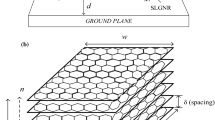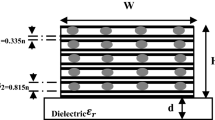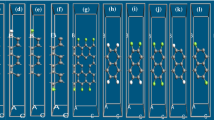Abstract
In this paper, a distributed model is used to examine the efficiency of zigzag graphene nanoribbons with antidots for local interconnect applications. Besides calculating the model parameters using precise equations and considering the full band-structure, the effects of introducing an antidot and its dimension on the performance of zigzag graphene nanoribbon interconnects are studied in HSPICE. The results of a local interconnect obtained from distributed transmission line show that: (1) While delay is directly related to resistance, capacitance, and inductance of the interconnect, rise-time, and fall-time are inversely related to inductance, and directly related to resistance, and capacitance. (2) Temperature is an effective parameter on the efficiency of the local interconnect; unlike global interconnect, temperature increase can decrease delay, rise-time, and fall-time. (3) By introducing antidot and adjusting its dimension, the rise-time, fall-time, and delay can be decreased significantly.









Similar content being viewed by others
References
Kaushik, B.K., Majumder, M.K.: Carbon nanotube based VLSI interconnects: Analysis and design. Springer, Berlin (2015)
Srivastava, N., Banerjee, K.: Interconnect challenges for nanoscale electronic circuits. J Min Metals Mater Soc TMS 56, 30 (2004)
Brain, R.: Interconnect scaling: challenges and opportunities. In: 2016 IEEE International Electron Devices Meeting (IEDM) (2016)
Weste, N., Harris, D.: CMOS VLSI Design: A Circuits and Systems Perspective. Pearson Education India, New Delhi (2010)
Todri-Sanial, A., Dijon, J., Maffucci, A.: Carbon Nanotubes for Interconnects. Springer, Berlin (2017)
Davis, J.A., Meindl, J.D.: Compact distributed RLC interconnect models. Part I: Single line transient, time delay, and overshoot expressions. IEEE Trans. Electron Dev. 47, 2068 (2000)
Raveloa, B.: Delay modeling of high-speed distributed interconnect for the signal integrity prediction. Eur. Phys. J. Appl. Phys. 57, 31002 (2012)
Kim, S., Wong, S.S.: Closed-form RC and RLC delay models considering input rise time. IEEE Trans. Circuits Syst. I Regul. Pap. 54, 2001 (2007)
Datta, M., Sahoo, S., Kar, R.: An explicit model for delay and rise time for distributed RC on-chip VLSI interconnect. In: 2010 International Conference on Signal and Image Processing, IEEE, pp. 368–371 (2010)
Mahmoud, N. H., Ismail, Y. I.: Accurate rise time and overshoots estimation in RLC interconnects. In: Proceedings of the 2003 International Symposium on Circuits and Systems, 2003. ISCAS'03, vol. 5: IEEE, pp. V-V (2003).
Awwad, F. R., Lammoshi, T., Nekili, M.: Importance of on-chip inductance in designing RLC VLSI interconnects. In: The 14th International Conference on Microelectronics, IEEE, pp. 177–180 (2002)
Ismail, Y.I., Friedman, E.G., Neves, J.L.: Exploiting the on-chip inductance in high-speed clock distribution networks. IEEE Trans. Very Large Scale Integr. (VLSI) Systems, 9, 963 (2001)
Murali, R., Yang, Y., Brenner, K., Beck, T., Meindl, J.D.: Breakdown current density of graphene nanoribbons. Appl. Phys. Lett. 94, 243114 (2009)
Singh, K., Raj, B.: Performance and analysis of temperature dependent multi-walled carbon nanotubes as global interconnects at different technology nodes. J. Comput. Electron. 14, 469 (2015)
Kaur, T., Rai, M.K., Khanna, R.: Effect of temperature on the performance analysis of MLGNR interconnects. J. Comput. Electron. 18(2), 722–736 (2019)
Liang, G., Neophytou, N., Nikonov, D.E., Lundstrom, M.S.: Performance projections for ballistic graphene nanoribbon field-effect transistors. IEEE Trans. Electron Dev. 54(4), 677–682 (2007)
Lemme, M.C., Echtermeyer, T.J., Baus, M., Kurz, H.: A graphene field-effect device. IEEE Electron Dev. Lett. 28(4), 282–284 (2007)
Echtermeyer, T.J., Lemme, M.C., Baus, M., Szafranek, B.N., Geim, A.K., Kurz, H.: Nonvolatile switching in graphene field-effect devices. IEEE Electron Dev. Lett. 29(8), 952–954 (2008)
Banszerus, L., Schmitz, M., Engels, S., Goldsche, M., Watanabe, K., Taniguchi, T., Stampfer, C.: Ballistic transport exceeding 28 μm in CVD grown graphene. Nano Lett. 16(2), 1387–1391 (2016)
Zomer, P.J., Dash, S.P., Tombros, N., vanWees, B.J.: A transfer technique for high mobility graphene devices on commercially available hexagonal boron nitride. Appl. Phys. Lett. 99, 232104 (2011)
Rai, M.K., Chatterjee, A.K., Sarkar, S., Kaushik, B.K.: Performance analysis of multilayer graphene nanoribbon (MLGNR) interconnects. J. Comput. Electron. 15(2), 358–366 (2016)
Kumar, V.R., Majumder, M.K., Kukkam, N.R., Kaushik, B.K.: Time and frequency domain analysis of MLGNR interconnects. IEEE Trans. Nanotechnol. 14(3), 484–492 (2015)
Zhao, W.-S., Yin, W.-Y.: Comparative study on multilayer graphene nanoribbon (MLGNR) interconnects. IEEE Trans. Electromagn. Compat. 56, 638 (2014)
Atul Kumar Nishad and Rohit Sharma: Performance improvement in SC-MLGNRs interconnects using interlayer dielectric insertion. IEEE Trans. Emerg. Top. Comput. 3, 470 (2015)
Marmolejo-Tejada, J.M., Velasco-Medina, J.: Review on graphene nanoribbon devices for logic applications. Microelectron. J. 48, 18 (2016)
Filabadi, H.S., Alidash, H.K.: Graphene nanoribbon field-effect transistors-based digital general-purpose input/output block. ECS J. Solid State Sci. Technol. 9, 061002 (2020)
Tamersit, K.: New nanoscale band-to-band tunneling junctionless GNRFETs: potential high-performance devices for the ultrascaled regime. J. Comput. Electron. 20, 1147 (2021)
Lee, S., Lee, K., Liu, C.-H., Kulkarni, G.S., Zhong, Z.: Flexible and transparent all-graphene circuits for quaternary digital modulations. Nat. Commun. 3, 1018 (2012)
Kang, J., Sarkar, D., Khatami, Y., Banerjee, K.: Proposal for all-graphene monolithic logic circuits. Appl. Phys. Lett. 103, 083113 (2013)
Naeemi, A., Meindl, J.D.: Compact physics-based circuit models for graphene nanoribbon interconnects. IEEE Trans. Electron Devices 56, 1822 (2009)
Yazdanpanah, A., Pourfath, M., Fathipour, M., Kosina, H., Selberherr, S.: A numerical study of line-edge roughness scattering in graphene nanoribbons. IEEE Trans. Electron Devices 2, 433 (2012)
Han, M.Y., Ozyilmaz, B., Zhang, Y., Kim, P.: Energy band-gap engineering of graphene nanoribbons. Phys. Rev. Lett. 98, 206805 (2007)
Burke, P.J.: Luttinger liquid theory as a model of the gigahertz electrical properties of carbon nanotubes. IEEE Trans. Nanotechnol. 1, 129 (2002)
Lahiri, J., Lin, Y., Bozkurt, P., Oleynik, I.I., Batzill, M.: An extended defect in graphene as a metallic wire. Nature Nanotech. 5, 326 (2010)
Bahamon, D.A., Pereira, A.L.C., Schulz, P.A.: Third edge for a graphene nanoribbon: a tight-binding model calculation. Phys. Rev. B 83(15), 155436 (2011)
Datta, S.: Quantum Transport: Atom to Transistor. Cambridge University Press, Cambridge (2005)
Sevincli, H., Cuniberti, G.: Enhanced thermoelectric figure of merit in edge-disordered zigzag graphene nanoribbons. Phys. Rev. B 81, 113401 (2010)
Berger, C., et al.: Electronic confinement and coherence in patterned epitaxial graphene. Science 312, 1191 (2006)
Bolotin, K.I., et al.: Ultrahigh electron mobility in suspended graphene. Solid State Commun. 146, 351 (2008)
Wang, X., Ouyang, Y., Li, X., Wang, H., Guo, J., Dai, H.: Room-temperature all-semiconducting sub-10-nm graphene nanoribbon field- effect transistors. Phys. Rev. Lett. 100, 206803 (2008)
Chen, Z., Appenzeller, J.: Mobility extraction and quantum capacitance impact in high performance graphene field-effect transistor devices. In: 2008 IEEE International Electron Devices Meeting (2008).
Yang, Y., Murali, R.: Impact of size effect on graphene nanoribbon transport. IEEE Electron Dev. Lett. 31, 237 (2010)
Asselberghs, I. et al.: Graphene wires as alternative interconnects. In: 2015 IEEE International Interconnect Technology Conference and 2015 IEEE Materials for Advanced Metallization Conference (IITC/MAM), IEEE, pp. 317–320 (2015)
Das, S., Das, D., Rahaman, H.: Electro-thermal RF modeling and performance analysis of graphene nanoribbon interconnects. J. Comput. Electron. 17, 1695 (2018)
Landauer, R.: Spatial variation of currents and fields due to localized scatterers in metallic conduction. IBM J. Res. Dev. 1, 223 (1957)
Yamacli, S.: Extraction of the voltage-dependent quantum capacitance and kinetic inductance of GNRFETs: a first-principles study. J. Comput. Electron. 14, 249 (2015)
Naeemi, A., Meindl, J.D.: Design and performance modeling for single-walled carbon nanotubes as local, semiglobal, and global interconnects in gigascale integrated systems. IEEE Trans. Electron Devices 1, 26 (2007)
HSPICE® User Guide: Signal Integrity. E-2010.12, December 2010.
Author information
Authors and Affiliations
Corresponding author
Additional information
Publisher's Note
Springer Nature remains neutral with regard to jurisdictional claims in published maps and institutional affiliations.
Rights and permissions
About this article
Cite this article
Arjmandian, M., Karamitaheri, H. & Alidash, H.K. Zigzag graphene nanoribbon antidot lattice for local interconnect applications: a precise computational method. J Comput Electron 21, 411–421 (2022). https://doi.org/10.1007/s10825-022-01853-5
Received:
Accepted:
Published:
Issue Date:
DOI: https://doi.org/10.1007/s10825-022-01853-5




